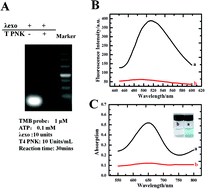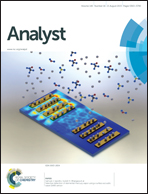One-strand oligonucleotide probe for fluorescent label-free “turn-on” detection of T4 polynucleotide kinase activity and its inhibition
Abstract
Thioflavin T (ThT), as one of the most exciting fluorogenic molecules, boasts the “molecular-rotor” ability to induce DNA sequences containing guanine repeats to fold into G-quadruplex structures. It has been demonstrated to sense this change by its remarkable fluorescence enhancement. In this work, taking T4 polynucleotide kinase (PNK) as a model, the ThT/G-quadruplex based platform and λexonuclease (λexo) cleavage reaction were combined to design a label-free “turn-on” strategy for fast, simple and accurate detection of T4 PNK activity and its inhibition. In the presence of T4 PNK, the designed thioflavin T based molecular beacon (TMB) DNA probe could be phosphorylated and then digested by the cleavage of λexo, releasing the G-quartets. These then bound to ThT to form ThT/G-quadruplexes with an obvious fluorescence generation, for the “turn-on” detection of T4 PNK. In comparison to traditional methods, the proposed TMB probe is convenient, requiring no sophisticated labeling and separation processes and displaying high analytical performance. It exhibits a satisfying detection result for the activity of T4 PNK with a low detection limit of 0.001 U mL−1. This is not only meaningful for further research on disease-related biochemical processes, but also valuable for molecular-target therapies.


 Please wait while we load your content...
Please wait while we load your content...